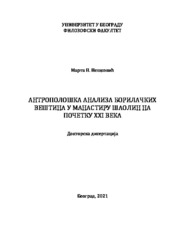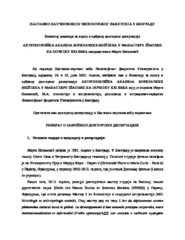Приказ основних података о дисертацији
Антрополошка анализа борилачких вештина у манастиру Шаолин на почетку XXI века
Anthropological analysis of martial arts in Shaolin Monastery at the beginning of the XXI century
| dc.contributor.advisor | Žikić, Bojan | |
| dc.contributor.other | Milenković, Miloš | |
| dc.contributor.other | Kovač, Senka | |
| dc.contributor.other | Pušić, Radosav | |
| dc.creator | Nešković, Marta | |
| dc.date.accessioned | 2022-05-25T07:02:29Z | |
| dc.date.available | 2022-05-25T07:02:29Z | |
| dc.date.issued | 2021-11-12 | |
| dc.identifier.uri | https://eteze.bg.ac.rs/application/showtheses?thesesId=8534 | |
| dc.identifier.uri | https://fedorabg.bg.ac.rs/fedora/get/o:25522/bdef:Content/download | |
| dc.identifier.uri | https://plus.cobiss.net/cobiss/sr/sr/bib/52847625 | |
| dc.identifier.uri | https://nardus.mpn.gov.rs/handle/123456789/19022 | |
| dc.description.abstract | Ова докторска теза бави се културним значењима борилачких вештина које се негују у манастиру Шаолин, провинција Хенан, Кина. Истраживање је усмерено на процес у којем се чан будистичка филозофија динамички отеловљује кроз праксу шаолинског кунгфуа у савременој Кини. При томе, кунгфу добија нова културна значења са својом специфичном естетиком. Посебнa пажњa je посвећена начинима учења и извођења ових телесних пракси, као саставног дела свакодневног живота шаолинске монашке заједнице, на којима се заснива и њихова глобална препознатљивост. Истраживање за ову тезу ослања се на теорије праксе које су дали Гиденс и Бурдје, као и на теорије отеловљења Чордаша и Џексон, али пре свега на теорију динамичког отеловљења коју су развили Вилијамс, Фарнел и Варела. Истраживање је спроведено применом квалитативног антрополошког приступа који је подразумевао боравак на терену у трајању од две и по године. У овом периоду, подаци су прикупљени опсервацијом са дубинским учествовањем у свакодневном животу манастира као и похађањем програма за стране ученике кунгфуа, као и спровођењем формалних интервјуа и неформалних разговора са припадницима заједнице манастира Шаолин. Текст дисертације подељен је у седам поглавља. У првом поглављу, са називом Циљеви и теоријско-методолошки оквир истраживања, представљени су циљеви и главна истраживачка питања, теоријско-методолошки оквир, аналитичко-интерпретативни приступ, као и преглед релевантне емпиријске литературе. Друго поглавље, Чан будизам и манастир Шаолин кроз историју, расветљава положај манастира Шаолин у контексту историјског развоја кинеског будизма и савремени значај ове верске институције. Ово поглавље у првом делу се бави односом државе спрам будизма и манастира Шаолин од времена династије Хан (206. п.н.е. – 220. н.е.), када је будизам доспео у Кину до данашњих дана. Други део говори о оснивању манастира Шаолин (5. век) и настајању различитих школа чан будизма, а трећи о настанку и развоју шаолинског кунгфуа у контексту традиционалних здравствених и борилачких дисциплина, као и ширих политичких и друштвених услова који су утицали на живот заједнице манастира током историје. Наредна три поглавља представљају срж ове докторске тезе. Она су посвећена излагању и анализи интервјуа три групе припадника шаолинске заједнице. Анализа њихових одговора спроведена је тако да одсликава заједничке теме које представљају основ истраживања, тј. перцепцију испитаника о преношењу знања и вештина у манастиру, као и њихово схватање односа између чан будизма, шаолинског кунфуа и здравља, али то чини кроз три различите перспективе. Треће по реду поглавље је насловљено Страни ученици кунгфуа у манастиру Шаолин. Оно почиње описом структуре образовног програма за стране ученике, наставља анализом њихове перцепције метода и искустава учења кунгфуа у манастиру, да би се завршило њиховим тумачењем различитих нивоа значења која се приписују шаолинском кунгфуу. Четврто поглавље, са називом Кунгфу-монаси у манастиру Шаолин, посвећено је оним припадницима шаолинске заједнице који имају манастиру Шаолин, посвећено је оним припадницима шаолинске заједнице који имају задатак да преносе манастирско кунгфу наслеђе с једне генерације на другу и јавно га презентују унутар и ван Кине. Ово поглавље се пре свега бави њиховом перцепцијом метода подучавања шаолинског кунгфуа као и схватањима о садржају и значају шаолинске културе. Религијски монаси у манастиру Шаолин, наслов је петог поглавља, које представља анализу поимања кунгфуа у контексту целокупне шаолинске културе, са акцентом на посматрању кунгфуа кроз различите чан праксе, као и његовог утицаја на здравље. Након поглавља која су била усмерена на одговоре сваке од три појединачне групе саговорника, последња два поглавља усмерена су на њихово повезивање кроз поређење, интерпретацију и синтезу. Тако шесто поглавље, названо Анализа и интерпретација, представља синтетичку интерпретацију и дискусију резултата целокупног истраживања. У њему се разматрају главни метанаративи манастирске заједнице и њених чланова, који се посматрају у контексту постојеће научне литературе, и преламају кроз искуства самог истраживача, стечена током дуготрајног боравка на терену. Најзад, Закључак резимира одговоре на главна истраживачка питања и излаже могући допринос ове докторске тезе антрополошкој теорији и емпирији. Допринос ове тезе је двојак. Ово је прво истраживање борилачких вештина у којем је примењена и продубљена теорија динамичког отеловљења. Поред тога, ово је за сада једина студија уопште у којој је спроведена дубинска антрополошка анализа пракси борилачких вештина које се негују у манастиру Шаолин, тј. анализа шаолинског кунгуфа у његовом изворном религијском окружењу. | sr |
| dc.description.abstract | This doctoral thesis deals with cultural meanings of the martial arts nurtured in the Shaolin Monastery, Henan Province, China. The research is focused on the process in which the Chan Buddhist philosophy is being dynamically embodied through the practice of Shaolin Kungfu in contemporary China. Thereby, Kungfu obtains new cultural meanings with their specific aesthetics. Special attention is paid to the modes of learning and performing these body practices, as part of everyday life of the Shaolin monastic community, which are also the basis of their global recognition. The thesis is inspired by theories of practice offered by Giddens and Bourdieu as well as theories of embodiment given by Csordas and Jackson, but most of all by the theory of dynamic embodiment developed by Williams, Farnell and Varela. Research was implemented through qualitative anthropological methods, which assumed two-and-a-half-year long fieldwork. In this period, ethnographic data was gathered through observation with deep participation in the everyday life of the monastery and attendance of the Shaolin Kungfu program for foreign students, as well as by conducting formal interviews and informal conversations with the members of the Shaolin Monastery community. The text of the thesis is divided into seven chapters. The first chapter, titled Aims, Theory and Methodology starts with the aims and main research questions, continues with the presentation of theoretical and methodological framework, as well as analytical and interpretative approach, and ends with the overview of relevant empirical literature. The second chapter, Chan Buddhism and Shaolin Monastery through History, sheds light on the status of Shaolin Monastery in the context of historical development of Chinese Buddhism, and its contemporary significance. In its first part, this chapter deals with the attitude of the state towards Buddhism and Shaolin Monastery from the time of Han Dynasty (206. BC – 220 AD), when this religion was introduced in China, to the present day. The second part speaks about the founding of Shaolin Monastery (5th century) and the growth of different schools of Chan, while the third part relates to the development of Shaolin Kungfu in the context of traditional health and fighting practices, as well as the wider political and social conditions that influenced the life of monastic community throughout history. The three chapters that follow are essential parts of this doctoral thesis. They are devoted to presentation and analysis of interviews with three groups of Shaolin community members. Analysis of their responses to the interview questions was conceived to bring forth the common themes that comprise the core research questions. Coming from three different perspectives, the answers relate the respondents’ perceptions on the transfer of knowledge and skills in the monastery as well as their understanding of the relationship between Chan Buddhism, Shaolin Kungfu and health. The third chapter is entitled Foreign Students of Kungfu in the Shaolin Monastery. It starts with the description of the structure of educational program for foreign students, continues with the analysis of their perception of the teaching methods and experiences of learning kungfu in the monastery, and ends with their interpretation of different levels of meaning they ascribe to Shaolin Kungfu. The fourth chapter, titled Warrior Monks in Shaolin Monastery, is devoted to those members of the Shaolin community who have the task of carrying on the kungfu monastic heritage from one generation to the other, and of publicly presenting it within and outside China. This chapter is primarily devoted to their perception of the kungfu teaching method and their understanding of the content and significance of Shaolin culture. Religious Monks in Shaolin Monastery is the fifth chapter, which presents the analysis of the religious monks’ conceptualization of kungfu in the context of the overall Shaolin culture, with an accent on observing kungfu through different Chan practices, as well as its influence on health. While the previous chapters focused on the responses of three distinct groups of respondents, the last two chapters are devoted to their interconnections through comparison, interpretation and synthesis. The sixth chapter, entitled Analysis and Interpretation, presents a synthetic interpretation and discussion of the overall research results. It considers the main metanarratives of the monastic community and its members, which are viewed in the context of relevant scientific literature, and mirrored in long-term fieldwork experiences of the researcher herself. Lastly, the Conclusion offers responses to the main research questions and suggests potential contribution of this doctoral thesis to anthropological theory and empirical research. This is the first study, which applied and deepened the theory of dynamic embodiment in the field of martial arts. This is also the only study so far, which implemented deep anthropological analysis of the martial arts practice cultivated in Shaolin Monastery, i.e., the analysis of Shaolin Kungfu in its original religious setting. | en |
| dc.format | application/pdf | |
| dc.language | sr | |
| dc.publisher | Универзитет у Београду, Филозофски факултет | sr |
| dc.rights | openAccess | en |
| dc.source | Универзитет у Београду | sr |
| dc.subject | антропологија | sr |
| dc.subject | anthropology | en |
| dc.subject | martial arts | en |
| dc.subject | body movement | en |
| dc.subject | dynamic embodiment | en |
| dc.subject | habitus | en |
| dc.subject | Shaolin Kungfu | en |
| dc.subject | Shaolin Monastery | en |
| dc.subject | Chan Buddhism | en |
| dc.subject | intangible cultural heritage | en |
| dc.subject | China | en |
| dc.subject | борилачке вештине | sr |
| dc.subject | телесни покрет | sr |
| dc.subject | динамички отеловљење | sr |
| dc.subject | хабитус | sr |
| dc.subject | шаолински кунгфу | sr |
| dc.subject | манастир Шаолин | sr |
| dc.subject | чан будизам | sr |
| dc.subject | нематеријално културно наслеђе | sr |
| dc.subject | Кина | sr |
| dc.title | Антрополошка анализа борилачких вештина у манастиру Шаолин на почетку XXI века | sr |
| dc.title.alternative | Anthropological analysis of martial arts in Shaolin Monastery at the beginning of the XXI century | en |
| dc.type | doctoralThesis | |
| dc.rights.license | ARR | |
| dcterms.abstract | Жикић, Бојан; Пушић, Радосав; Миленковић, Милош; Ковач, Сенка; Нешковић, Марта; Antropološka analiza borilačkih veština u manastiru Šaolin na početku XXI veka; | |
| dc.identifier.fulltext | http://nardus.mpn.gov.rs/bitstream/id/142741/Referat_Neskovic.pdf | |
| dc.identifier.fulltext | http://nardus.mpn.gov.rs/bitstream/id/142740/Disertacija_12176.pdf | |
| dc.identifier.rcub | https://hdl.handle.net/21.15107/rcub_nardus_19022 |



